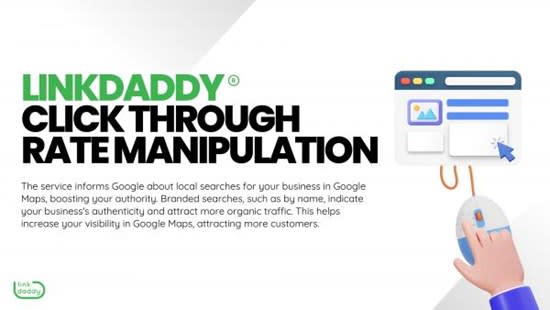CTR Manipulation: A Game Changer for Digital Projects
The increase of CTR manipulation has actually indisputably transformed electronic advertising and marketing strategies, supplying marketing professionals with tools to boost engagement and drive traffic properly. What ramifications might this stabilizing act hold for the future of digital projects?
Recognizing CTR Control
Although click-through price (CTR) manipulation might appear like a simple method in digital advertising and marketing, it encompasses a series of strategies focused on unnaturally blowing up engagement metrics. This control can take numerous forms, consisting of the usage of click farms, crawlers, or deceitful ad positionings that mislead consumers into clicking. These strategies can compromise the integrity of performance information, making it testing for online marketers to determine the genuine efficiency of their projects.
In addition, CTR manipulation raises honest problems, as it threatens the transparency of digital marketing. The dependence on filled with air metrics can bring about misguided advertising decisions, skewing source appropriation and campaign techniques. Businesses may invest greatly in networks and methods that show up effective but do not yield real engagement or conversions.

Advantages of Click-Through Price Optimization
Enhancing click-through rate (CTR) is important for enhancing the efficiency of electronic advertising campaigns. A greater CTR shows that a bigger percentage of customers are involving with the content, which can result in boosted internet site web traffic and much better conversion prices. By boosting CTR, brands can effectively allocate their advertising and marketing sources to efforts that generate the highest returns.
Among the primary advantages of CTR optimization is the capacity for improved advertisement placement and reduced expenses - CTR Manipulation. Platforms like Google Advertisements reward greater CTRs with much better advertisement positioning and minimized cost-per-click (CPC), allowing marketers to extend their budgets additionally. Additionally, a well-optimized CTR can boost brand presence, as greater interaction prices usually correlate with raised natural reach

Methods for Effective CTR Control
To properly adjust click-through rates (CTR), marketing experts can utilize a selection of critical methods that enhance customer involvement and drive traffic. One essential strategy is optimizing ad duplicate to create compelling and action-oriented language. CTR Manipulation. Using solid call-to-action (CTA) expressions encourages individuals to take instant activity, enhancing the probability of clicks
An additional effective technique is A/B testing, which enables marketers to compare different ad variants. By methodically assessing performance metrics, they can identify which aspects resonate finest with the target audience, consequently improving their approaches for optimal influence. In addition, leveraging aesthetically enticing graphics and succinct messaging can catch interest quickly, making it a lot more potential that customers will involve.

Lastly, enhancing landing pages to ensure a seamless customer experience can lower bounce prices and motivate further interaction, inevitably promoting higher CTR. By incorporating these strategies, online marketers can effectively manipulate CTR to accomplish their campaign purposes.
Gauging Success in Digital Campaigns
Measuring success in electronic campaigns requires a clear understanding of key efficiency signs (KPIs) that align with project goals. KPIs act as measurable metrics that assist evaluate the effectiveness of numerous methods employed throughout the project. Typical KPIs consist of click-through prices (CTR), conversion rates, price per purchase (CPA), and return on financial investment (ROI)
To successfully measure success, it is crucial to develop particular, measurable objectives first of the project. If the key goal is to enhance brand name awareness, metrics such as impacts and engagement prices may check this be focused on. In comparison, campaigns concentrated on direct sales would certainly gain from read the full info here a much more detailed evaluation of conversion rates and earnings produced.
Regular analysis of these KPIs allows online marketers to make data-driven decisions, enhancing their approaches in real-time. Using logical tools can help in monitoring efficiency and identifying patterns, permitting swift modifications to boost project outcomes. Inevitably, a thorough strategy to gauging success not only highlights areas for enhancement yet additionally reinforces the overall efficiency of electronic advertising and marketing efforts, driving sustained growth and interaction in the long-term.
Future Patterns in Digital Advertising And Marketing
Anticipating the future of digital advertising exposes a landscape formed by fast technical innovations and transforming customer actions. As synthetic intelligence and device knowing remain to progress, marketing experts will increasingly leverage these technologies to personalize campaigns at an unprecedented scale. Predictive analytics will certainly enable brands to anticipate customer needs, optimizing ad positionings and material distribution in genuine time.
Additionally, the increase of voice search and wise gadgets is transforming just how customers interact with electronic content. Marketing professionals will need to adjust their approaches to guarantee visibility throughout numerous systems, consisting of voice-activated aides. This shift requires a concentrate on conversational advertising and marketing, emphasizing engagement via discussion instead of conventional promotional methods.
Furthermore, privacy problems are triggering changes in information collection methods. Check This Out Openness and honest data use will come to be vital, driving brands to cultivate count on and commitment among customers. The continuous advancement of social networks platforms will certainly likewise influence advertising and marketing techniques, with a heightened focus on authenticity and user-generated content.
Conclusion
In recap, CTR adjustment represents a considerable advancement in digital advertising and marketing strategies, providing instant advantages through improved involvement metrics. Nevertheless, the honest factors to consider surrounding such practices demand a careful technique to guarantee long-lasting brand name honesty and genuine audience link. By striking an equilibrium in between optimization strategies and genuine involvement, marketers can cultivate sustainable connections with customers. The continuous development of digital marketing will depend on this fragile interaction, shaping the future landscape of brand-consumer communications.